
- •Lesson (1) Cell theory
- •Importance
- •Lesson (2) Cell ultra structure
- •L eucoplasts (White plastids)
- •Lesson (3) Differentiation of cells and diversity of plant and animal tissues
- •Lesson (4) Cell processes
- •Importance of stem cells:-
- •Importance of cell fractionation technique:-
- •Answer four questions only
Lesson (3) Differentiation of cells and diversity of plant and animal tissues
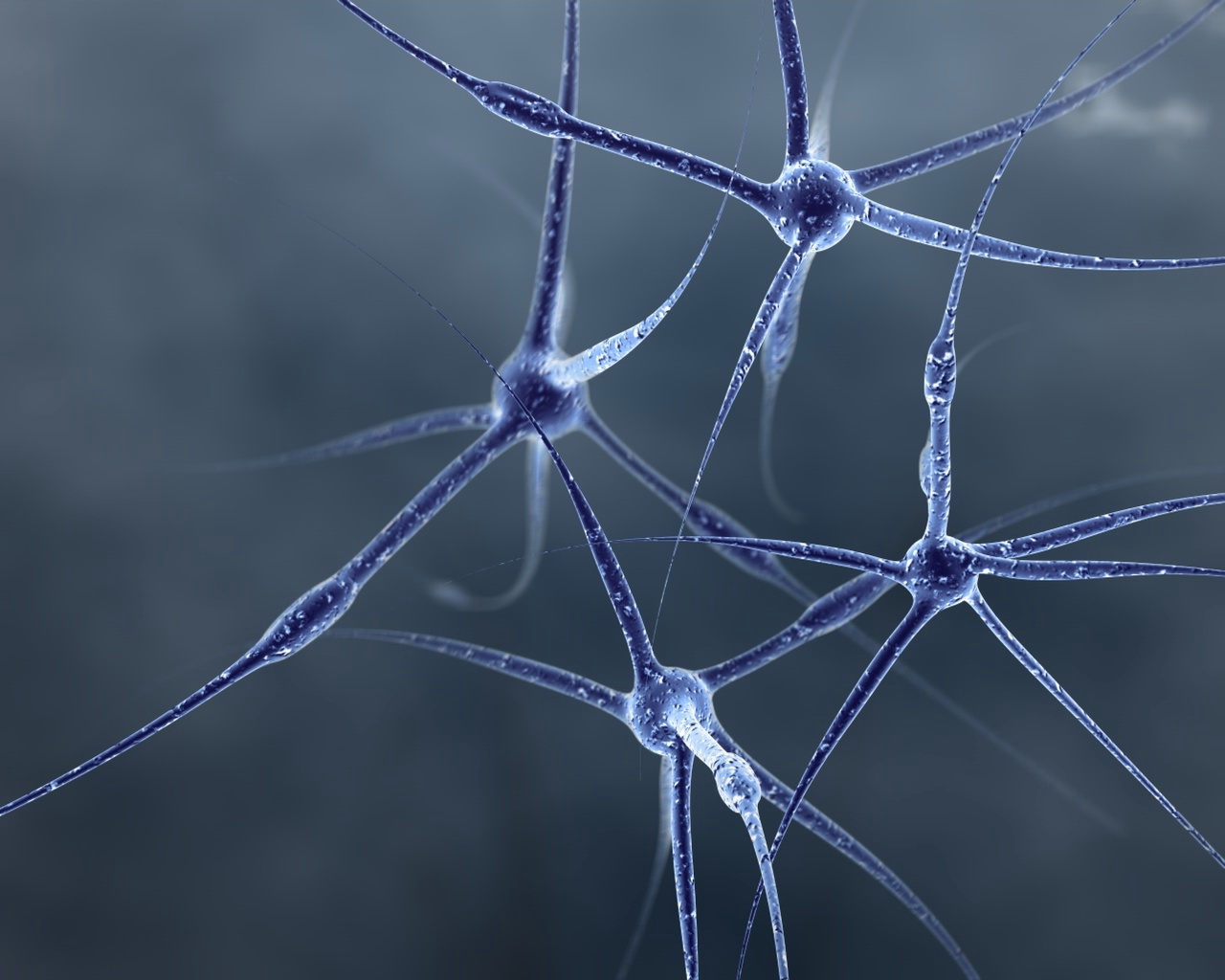
![]()
There are many types of cells, every kind of cells has a particular function, cells unite together forming tissues .
There are two types of tissues, which are:-
Simple tissues: They are tissues formed from identical cells.
Complex tissues: They are tissues formed from different types of cells.
Tissues unite together forming organs (ex. Heart), organs unite together forming systems (ex. Circulatory system). These systems form living organisms' bodies
![]()
1- Simple tissues
1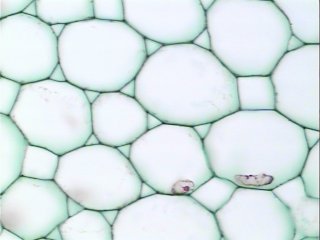 -
Parenchyma tissue
-
Parenchyma tissue
Definition: A living tissue with thin and flexible
walls whose cells have spherical or ellipsoidal
shapes. These cells may be coloured, green or
colourless.
There are spaces for aeration between the
cells of Parenchyma tissue. Parenchyma cell
contains one or more vacuoles filled with water
and mineral salts.
Fig. (21) Parenchyma tissue
Function of Parenchyma tissue:-
1- Performing photosynthesis process
2- Storing nutrients such as starch
3- Responsible for aeration.
2- Collenchyma tissue (flexible tissue)
Definition: A living tissue whose cells are semi-rectangular, its walls are irregularly thickened with cellulose.
Function: Supporting the plant by providing it with suitable flexibility.

Fig. (22) Collenchyma tissue
3 -
Sclerenchyma tissue (solid tissue)
-
Sclerenchyma tissue (solid tissue)
Definition: A non-living tissue, the walls of its
cells are thickened by a substance called Lignin.
Function of Sclerenchyma tissue: It supports
the plant and gives it flexibility and solidity.
Fig. (23) Sclerenchyma tissue
2- Complex tissue
They are divided into:-
1- Xylem (wood tissue)
T hey
are composed of :-
hey
are composed of :-
- Xylem vessel elements: They are tubes which consist of
a vertical row of cells which lost protoplasm and their
horizontal walls. Then, Lignin precipitated inside those
cells changing them to long wide vessels through which
water and mineral salts can be transported.
- Xylem trancheids: Each trancheid is composed of one
cell which lost protoplasm and its cell wall is thickened
with Lignin.
Fig. (24) Xylem tissue
- Parenchyma cells
Function of xylem:-
1- It transports salts and water from roots to leaves
2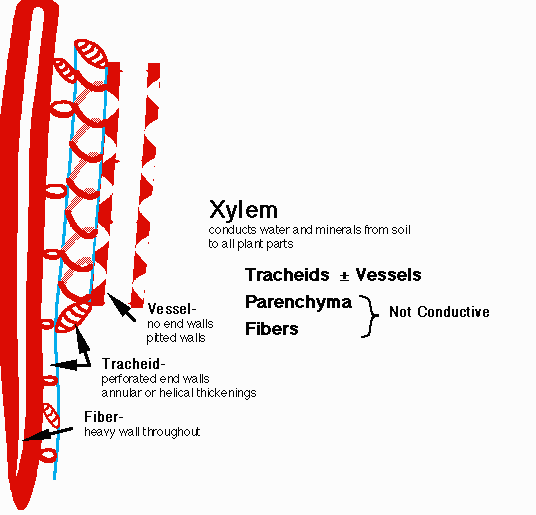 -
It supports the plant
-
It supports the plant
Fig. (25) Structure of xylem
2- Phloem
Sieve cells are formed from vertically-arranged cells which lost their nuclei and their walls separating between them became holed which are known as Sieve plates. Cytoplasm permeates these sieve plates in the form of cytoplasmic filaments.
There are some living cells near sieve tubes known as companion cells, these cells provide sieve tube with energy.
The function of Phloem:-
It transports the substances resulted from photosynthesis process from leaves to all parts of plant.
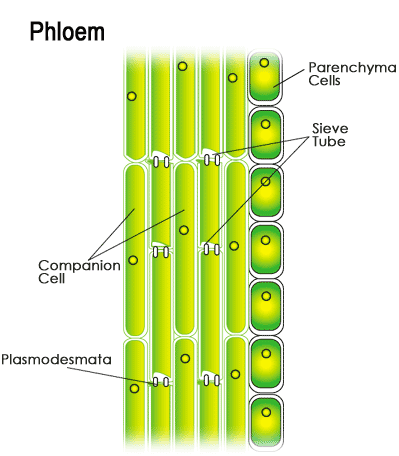
Fig. (26) Phloem structure
![]()
1- Epithelial tissues
They are cells which cover the surface of body or line its cavity, it consists of a great number of attached cells with little intracellular substances between them
There are two types of epithelial tissues, which are:-
1- Simple epithelial tissues
Their cells are ordered in one layer, for example:-
1- Simple squamous epithelial tissue: It is composed of one layer of flat cells
Examples: Capillary linings – The walls of air alveoli in lungs
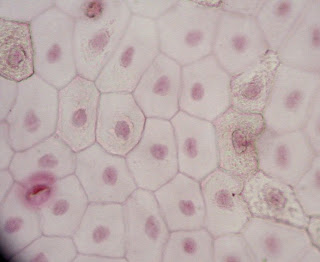
Fig. (27) Simple squamous epithelial tissue
2- Simple cuboidal epithelial tissue: It is composed of one layer of cuboidal cells.
Examples: The lining of kidney tubules.
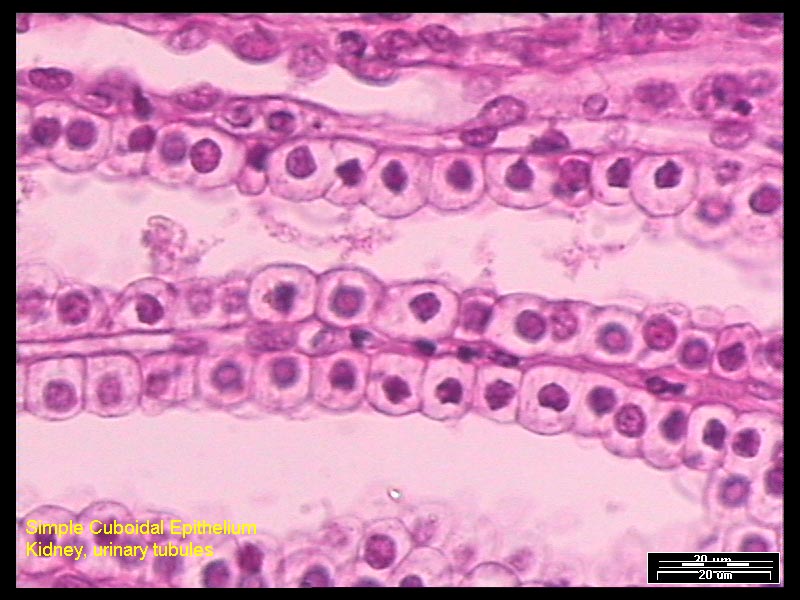
Fig. (28) Simple cuboidal epithelial tissue
3- Simple columnar epithelial tissue: Composed of one layer of columnar cells.
Examples: The lining or stomach and intestine
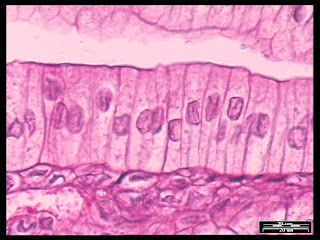
Fig. (29) Simple columnar epithelial tissue
2- Complex (stratified) epithelial tissue
Its cells are arranged in many layers
Stratified squamous epithelial tissue: It is composed of many layers or arranged cells above each other, the upper layer is squamous.
Example: Skin
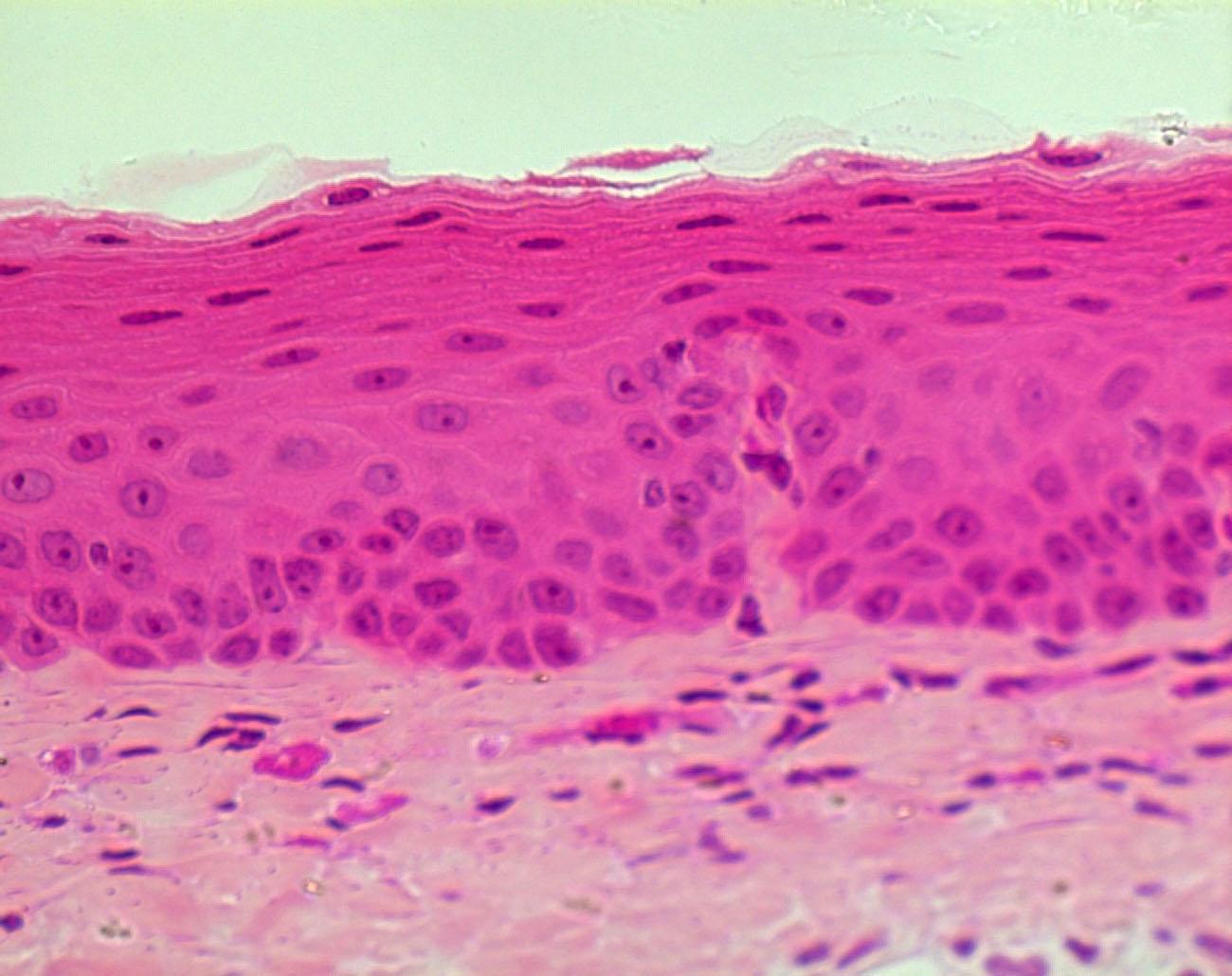
Fig. (30) Stratified squamous epithelial tissue
The functions of epithelial tissues:-
They perform different functions according to their locations, such as:-
- Absorbing water and digested food as in the lining of small intestine.
- Protecting the cells they cover from dryness and harms as in skin
- Secreting mucus to keep the cavity soft and moist as in air trachea and digestive canal
2- Connective tissues
They are composed of relatively distant cells, the intracellular spaces between them are filled by liquid, semi-solid, or solid substances..
Connective tissues are classified according to the type of intracellular material into:-
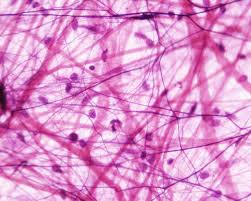
1- Proper connective tissues: The most common type,
it has a medium degree of solidity and high flexibility
Function: Connecting tissues and different organs
with each other.
Example: Under skin – Peritoneum (in small intestine)
Fig. (31) Proper connective tissue
2- Skeletal connective tissue: It has solid intracellular substance (in bones, calcium is precipitated in it)
Examples: Bones – Cartilages
Function: Supporting the body
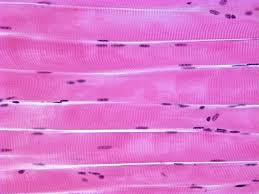
Fig. (32) Skeletal connective tissue
3- Vascular connective tissue: It has liquid intracellular substance.
Function: Transporting digested food, gases and execrations.
Examples: Blood – Lymph
3- Muscular tissues
They have the ability to contract and relax, which enable living organisms to move.
There are three kinds of muscular tissues, which are:-
1- Smooth muscles: They are composed of involuntary non-striated muscles fibres.
Examples: They exist in the wall of digestive canal, urinary system and blood vessels
2- Skeletal muscles: They are composed of striated voluntary muscles, they are usually found attached to the skeleton.
Example: The muscles of hands, legs and stem
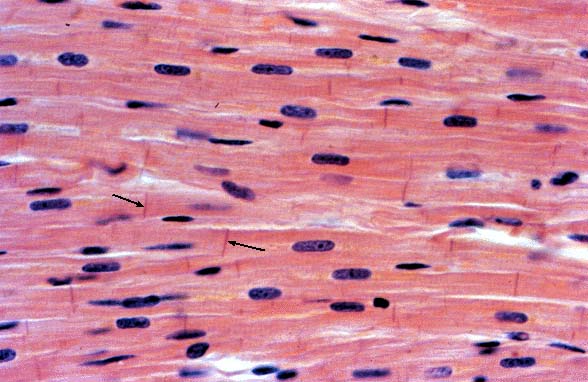
3- Cardiac muscles: They are composed of striated
involuntary muscles, they are found in the walls of
heart only. Cardiac muscles contain intercalated
disks which are attached to muscle fibers, they make
heart pump blood regularly.
Fig. (33) Cardiac muscles
4- Nervous tissues
They are responsible for regulating the different functions or body organs because:-
They receive sensory stimuli inside or outside the body and send them to the brain and spinal cord. Then, it sends movement orders to responding organs.
Fig. (34) Nerve cell
![]()
Parenchyma tissue: A living tissue composed of irregular cells with thin walls and intracellular distances between them. It is responsible for aeration, photosynthesis process and storing nutrients like starch.
Collenchyma tissue: A living tissue composed of rectangular cells, its wall are not thickened with Lignin but with cellulose
Sclerenchyma tissue: A tissue which supports the plant and protects its inner tissues.
Epithelial tissue: A tissue which covers the outer surface of body to protect it from outer stimuli (Temperature, Dryness, Microbes,) or line the body from inside.
Connective tissue: A tissue whose cells are relatively distant and it has a solid, liquid or semi-solid intracellular material.
Muscular tissue: A tissue which is known as muscular cells or fibres, it has the ability to contract and relax (which doesn't exist in all body cells)
Smooth muscles: Muscles which are composed of involuntary non-striated muscles fibres.
Skeletal muscles: They are composed of striated voluntary muscles, they are usually found attached to the skeleton.
Cardiac muscles: They are composed of striated involuntary muscles, they are found in the walls of heart only
Nervous tissue: A tissue whose cells receive sensatory stimuli and transporting movements orders.
![]()
1- Parenchyma tissues play an important role in plants
Because they are responsible for aeration and photosynthesis processes and storage of nutrients such as starch in plants
2- Collenchyma tissues are very important in plants
Because it supports the plant by making it flexible
3- The biological importance of Sclerenchyma tissues
Because they support the plant by making it flexible and solid
4- Xylem is from the most important tissues in plants and trees
Because it transports water and salts from their roots to their leaves
5- Phloem is from the most important tissues in plant and trees
Because it transports nutrients produced by photosynthesis process from plants' leaves to all their parts
6- In phloem tissues, there are living cells attached to these tissues sieve tubes
In order to provide them with energy
7- Epithelial tissues cover the outer surface of living organisms
In order to protect the cells under these surfaces from microbes, damage and dryness
8- Epithelial tissues line the small intestines of living organisms
To absorb water and digested food
9- Epithelial tissues exist in cavities such as digestive canal and air trachea
In order to keep them moist and soft by secreting mucus
10- Proper connective tissues are from the most important tissues in living organisms
Because they connect different tissues and organs with each other
11- The biological importance of vascular connective tissues
Because they transport water, nutrients and wastes around the bodies of living organisms
12- Skeletal muscles are so-called (called by this name)
Because skeletal muscles are found attached to skeleton (such as the muscles of hands and legs)
13- Cardiac muscles are found attached to intercalated disks.
To allow heart work and pump blood regularly
14- Muscle tissues have so many mitochondria
To provide muscles with the energy required for them to perform their functions perfectly.
![]()
1- Plants and trees didn't have Parenchyma tissue
Plants wouldn't be able to perform photosynthesis process and store nutrients.
2- Plants and trees didn't have Collenchyma (or Sclerenchyma) tissues
The plant wouldn't be flexible
3- Xylem tissues didn't exist in trees and plants
The roots of plants wouldn't be able to transport salts and water to their leaves, and the plant won't be supported
4- Phloem tissues didn't exist in trees and plants
The nutrients produced during photosynthesis process wouldn't be transported from the plants' leaves to all its parts.
5- The outer surfaces of organisms weren't covered with epithelial tissues.
Their cells would be damaged
6- Epithelial tissues in small intestine disappears.
It won't be able to absorb food and water
7- Epithelial tissues in cavities like air trachea are absent
Mucus won't be secreted in these cavities and they won't be moist and soft.
8- Muscle tissues cells don't have many mitochondria
They will work improperly due to the lack of energy.
![]()
1- Choose the correct answer
1- The tissue which is responsible for storing nutrients in plants
A- Parenchyma B- Sclerenchyma C- Collenchyma D- Phloem
2- Cell walls of Collenchyma tissues cells are thickened with ……….
A- Lignin B- Cellulose C- Chitin D- Glucose
3- The solid tissue is known as ………..
A- Sclerenchyma B- Collenchyma C- Epithelium D- Parenchyma
4- The cell walls of Sclerenchyma tissues cells are thickened with……..
A- Lignin B- Cellulose C- Chitin D- Glucose
5- The tissue which is responsible for transporting water and salts from roots to leaves.
A- Xylem B- Phloem C- Sclerenchyma D- Parenchyma
6- The plant tissue which transport nutrients from leaves to all plant parts.
A- Collenchyma B- Sclerenchyma C- Xylem D- Phloem
7- An epithelial tissue which forms the lining of capillaries
A- Simple columnar epithelial tissue
B- Simple vascular epithelial tissue
C- Simple squamous epithelial tissue
D- Stratified squamous epithelial tissue
8- A tissue formed from one layer of flat cells.
A- Simple columnar epithelial tissue
B- Simple vascular epithelial tissue
C- Simple squamous epithelial tissue
D- Stratified squamous epithelial tissue
9- A tissue forming kidney tubules.
A- Simple columnar epithelial tissue
B- Simple vascular epithelial tissue
C- Simple squamous epithelial tissue
D- Stratified squamous epithelial tissue
10- Tissues which support body.
A- Skeletal connective tissues
B- Vascular connective tissues
C- Simple squamous epithelial tissue
D- Stratified squamous epithelial tissue
11- ……… are formed from non-striated involuntary muscle fibers
A- Smooth muscles
B- Skeletal muscles
C- Cardiac muscles
D- Skeletal connective tissues
12- ……… are formed from striated voluntary muscle fibers
A- Smooth muscles
B- Skeletal muscles
C- Cardiac muscles
D- Skeletal connective tissues
2- Write the scientific term
1- A living tissue composed of irregular cells with thin walls and intracellular distances between them for aeration
2- A living tissue composed of rectangular cells, its wall are not thickened with Lignin but with cellulose
3- A tissue which supports the plant and protect the inner tissues.
4- A tissue which covers the outer surface of body to protect it from outer stimuli (Temperature, Dryness, Microbes,) or line the body from inside.
5- A tissue whose cells are relatively distant and it has a solid, liquid or semi-solid intracellular material.
6- A tissue which is known as muscular cells or fibres, it has the ability to contract and relax (which doesn't exist in all body cells)
7-Muscles which are composed of involuntary non-striated muscles fibres.
8- They are composed of striated voluntary muscles, they are usually found attached to the skeleton.
9- They are composed of striated involuntary muscles, they are found in the walls of heart only
![]()
1- Choose
1- Parenchyma 2- Cellulose 3- Sclerenchyma 4- Lignin 5- Xylem
6- Phloem 7- Simple squamous epithelial tissue 8- Simple squamous epithelial tissue 9- Simple cuboidal epithelial tissue 10- Skeletal connective tissue
11- Smooth muscle 12- Skeletal
2- Complete
1- Parenchyma 2- Collenchyma 3- Sclerenchyma 4- Epithelial tissue
5- Connective tissue 6- Muscular tissue 7- Smooth muscle 8- Skeletal muscles 9- Cardiac muscles
